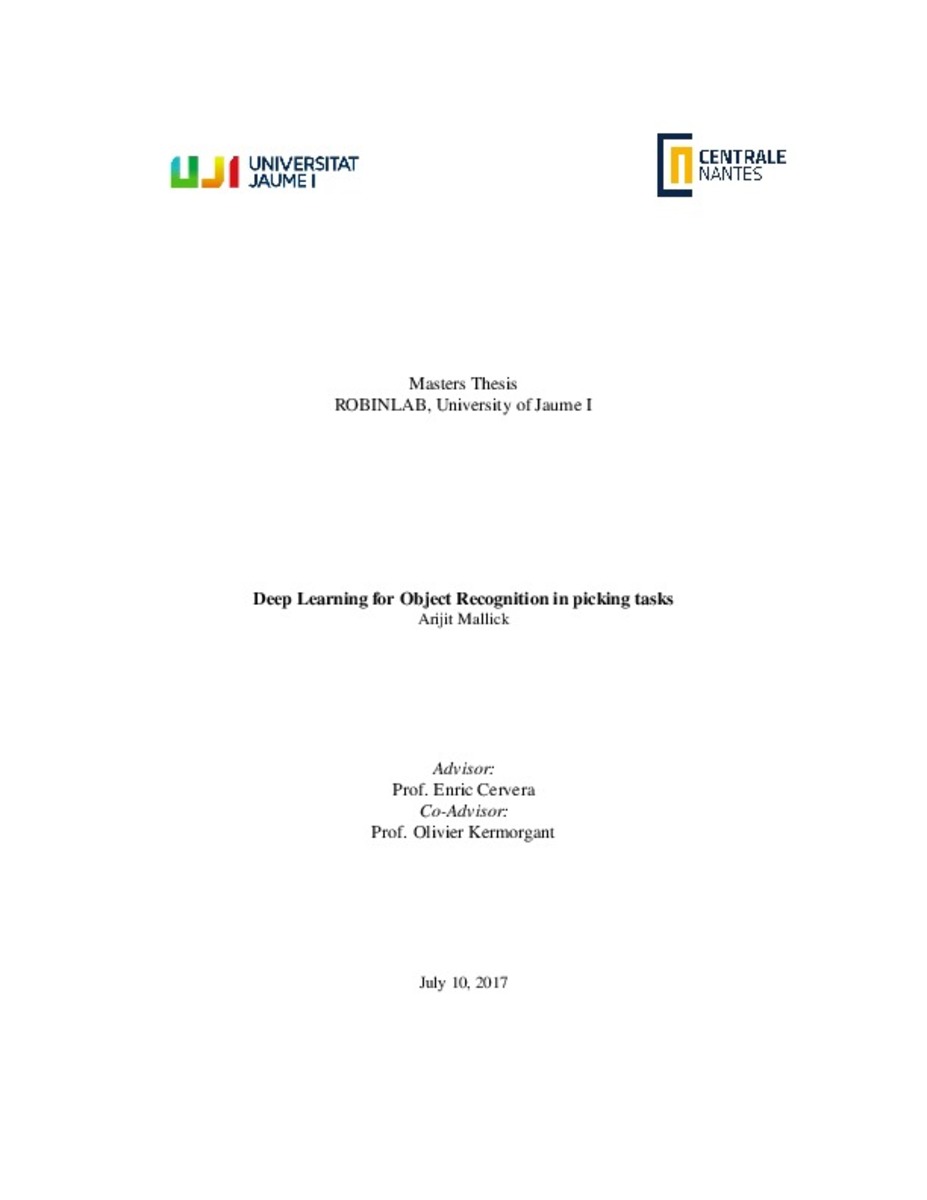Mostrar el registro sencillo del ítem
Deep Learning for Object Recognition in picking tasks
| dc.contributor.author | Mallick, Arijit | |
| dc.contributor.other | Cervera Mateu, Enric | |
| dc.contributor.other | Kermorgant, Olivier | |
| dc.contributor.other | Universitat Jaume I. Departament d'Enginyeria i Ciència dels Computador | |
| dc.date.accessioned | 2018-04-24T10:13:43Z | |
| dc.date.available | 2018-04-24T10:13:43Z | |
| dc.date.issued | 2017-07-13 | |
| dc.identifier.uri | http://hdl.handle.net/10234/174287 | |
| dc.description | Treball de Final de Màster Universitari Erasmus Mundus en Robòtica Avançada. Curs acadèmic 2016-2017 | ca_CA |
| dc.description.abstract | In the light of current advancement in deep learning, robot vision is not an exception. Many popular machine learning algorithms has already been proposed and implemented to solve intricate computer vision problems. The same has not been in the case of robot vision. Due to real time constraints and dynamic nature of environment such as illumination and processing power, very few algorithms are able to solve the object recognition problem at large. The primary objective of the thesis project is to converge into an accurate working algorithm for object recognition in a cluttered scene and subsequently helping the BAXTER robot to pick up the correct object among the clutter. Feature matching algorithms usually fail to identify most of the object having no texture, hence deep learning has been employed for better performance. The next step is to look for the object and localize it within the image frame. Although basic shallow Convolutional Neural Network easily identifies the presence of an object within a frame, it is very difficult to localize the object location within the frame. This work primarily focuses on finding a solution for an accurate localization. The first solution which comes to mind is to produce a bounding box surrounding the object. In literature, YOLO is found to be providing a very robust result on existing datasets. But this was not the case when it was tried on new objects belonging to the current thesis project work. Due to high inaccuracy and presence of a huge redundant area within the bounding box, an algorithm was needed which will segment the object accurately and make the picking task easier. This was done through semantic segmentation using deep CNNs. Although time consuming, RESNET has been found to be very efficient as its post processed output helps to identify items in a significantly difficult task environment. This work has been done in light of upcoming AMAZON robotic challenge where the robot successfully classified and distinguished everyday items from a cluttered scenario. In addition to this, a performance analysis study has also been done comparing YOLO and RESNET justifying the usage of the later algorithm with the help of performance metrics such IOU and ViG. | ca_CA |
| dc.format.extent | 49 p. | ca_CA |
| dc.format.mimetype | application/pdf | ca_CA |
| dc.language.iso | eng | ca_CA |
| dc.publisher | Universitat Jaume I | ca_CA |
| dc.rights | Attribution-NonCommercial-NoDerivatives 4.0 Internacional | * |
| dc.rights.uri | http://creativecommons.org/licenses/by-nc-nd/4.0/ | * |
| dc.subject | Màster Universitari Erasmus Mundus en Robòtica Avançada | ca_CA |
| dc.subject | Erasmus Mundus University Master's Degree in Advanced Robotics | ca_CA |
| dc.subject | Máster Universitario Erasmus Mundus en Robótica Avanzada | ca_CA |
| dc.title | Deep Learning for Object Recognition in picking tasks | ca_CA |
| dc.type | info:eu-repo/semantics/masterThesis | ca_CA |
| dc.educationLevel | Estudios de Postgrado | ca_CA |
| dc.rights.accessRights | info:eu-repo/semantics/openAccess | ca_CA |
| dc.audience.educationlevel | Estudios de Postgrado |








